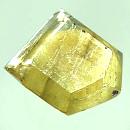|
|
|
|
Click on a letter above to view the list of gems. |
|
|
|
|
|
Muscovite
(Mica) |
|
| Chemistry:
KAl2[(OH)2|AlSi3O10] | |
| Discovered
in 1850;
IMA
status: Valid (pre-IMA; Grandfathered). | ||
|
| ||
|
Classification |
|
|
| |
|
Silicates | |
|
8/H.10-70 | |
|
|
9 : SILICATES (Germanates) |
|
Related to: |
Mica Group, Muscovite Series. |
|
|
|
|
Crystal Data |
|
|
|
|
|
Crystals tabular to columnar, striated, pseudohexagonal or diamond-shaped, to 4.5 m and 77 t. As stellate aggregates, plumose, globular; scaly, granular, compact massive. |
|
|
Composition plane [001], twin axis [310], forming six-pointed stars. |
|
|
|
|
|
Physical Properties |
|
|
|
|
|
[001] Perfect, Parting on [110] and [010] |
|
|
Micaceous |
|
|
Tough; laminae flexible and elastic |
|
|
2.0 - 2.5 |
|
|
2.77- 2.88 (g/cm3) |
|
|
None |
|
|
Barely Detectable; GRapi = 140.52 (Gamma Ray American Petroleum Institute Units) |
|
|
|
|
|
Optical Properties |
|
|
|
|
|
White, Gray, Silver White, Brownish White, Greenish White |
|
|
Transparent to Translucent |
|
|
Vitreous to Pearly or Silky |
|
|
1.552 - 1.618 Biaxial ( ? ) |
|
|
0.0340 - 0.0420 |
|
|
Weak to Distinct; r > v |
|
|
Weak when colored |
|
|
|
|
|
Occurances |
|
|
|
|
|
Geological Setting: |
A common rock-forming mineral, in phyllites, schists, and gneisses; in granites, granite pegmatites, and aplites. Formed from other minerals under hydrothermal conditions; may be detrital or authigenic. |
|
Common Associations: |
Biotite, Plagioclase, Potassic Feldspar, Quartz, Topaz, Tourmaline |
|
Common Impurities: |
Cr, Li, Fe, V, Mn, Na, Cs, Rb, Ca, Mg, H2O |
|
Type Locality: |
n/a |
|
Year Discovered: |
1850 |
|
View mineral photos: | |
|
|
|
|
More Information |
|
|
|
|
|
| |
|
|
|
|
|
|
|
We
have not photographed our Muscovite
(Mica) gems. Please
check back soon. |
